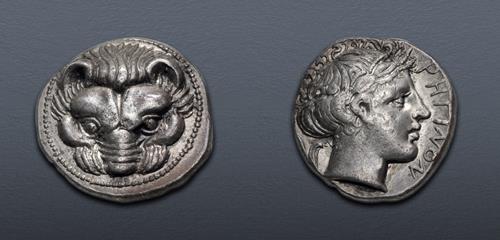
|
BRUTTIUM, Rhegion. Circa 415/0-387 BC. AR Tetradrachm (24mm, 17.14 g, 9h). Good VF.
CNG Feature Auction 124
Lot: 41. Estimated: $ 10 000
Greek, Coin-in-Hand Video, Silver
Sold For $ 18 000. This amount does not include the buyer’s fee.
Go to Live
|
|
BRUTTIUM, Rhegion. Circa 415/0-387 BC. AR Tetradrachm (24mm, 17.14 g, 9h). Lion mask facing / Head of Apollo right, wearing laurel wreath; olive sprig to left, PHΓINON to right. Herzfelder 90bis–91 var. (D54d/R– [unlisted rev. die]); SNG ANS 661 (same obv. die); HN Italy 2496; SNG Fitzwilliam 851 (same obv. die). Iridescent tone, shallow test cut on edge. Good VF. High relief.
This issue of coinage corresponds to quite an eventful period in the history of Rhegion. Around 415/0 BC, the reverse type on the tetradrachms changed from a seated figure to the head of Apollo. It is thought that this significant change was precipitated by a change in regime in the city. In the mid 5th century, Rhegion was a steadfast supporter of Athenian interests in Magna Graecia, especially in 427 BC, when Rhegion provided its port as a base from which Athens could operate. By the time of the Athenian Expedition in 415 BC, however, Rhegion refused to participate, and remained neutral, an act that effectively blocked Athens' access to the straits. The timing of the beginning of this issue roughly coincides with this event. Rhegion's ambivalence towards Athens, though, did not translate into support for the interests of Syracuse. Perhaps wishing to distance itself from the turmoil in Sicily, Rhegion allied itself with the other major cities of southern Italy in a coalition against Dionysios I, the tyrant of Syracuse. Unfortunately, this decision proved disastrous, as Dionysios invaded Bruttium, and fought against the cities from 399-386 BC, with the result that Rhegion was reduced to near non-existence until it was refounded by Dionysios II in 360 BC. It seems likely that the bountiful tetradrachm coinage struck during this period was used to finance military activity. In any event, these coins exemplify the high aesthetic standard of the Classical Period that is common to the coins of Magna Graecia at this time. The facing lion head is rendered in a bold, detailed manner, as is the head of Apollo, carefully depicted as a serene deity. What separates these coins from their contemporaries is the depth of the relief, which was extraordinarily high. The effect is particularly striking on the obverse, where the lion head has an unsurpassed exceptional three-dimensional quality.
The final winners of all CNG Feature Auction 124 lots will be determined during the live online sale that will be held on 19-20 September 2023. This lot is in Session One, which will begin 19 September at 9 AM ET.
Winning bids are subject to a 22.5% buyer's fee for bids placed on this website and 25% for all others.
We recognize that our users may have various Internet Browsers and Operating Systems. We like our visitors to have the best possible experience when using our bidding platform. However, we do recognize that it is impossible to develop applications that work identically, efficiently and effectively on all web browsers. The CNG bidding platform supports the latest stable major version and stable previous version of Chrome and Firefox.
|
